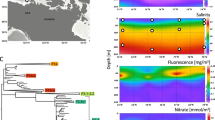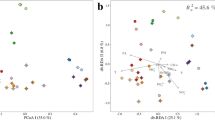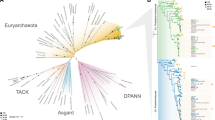Abstract
Bacterioplankton phylotypes of α-Proteobacteria have been detected in various marine regions, but systematic biogeographical studies of their global distribution are missing. α-Proteobacteria comprise one of the largest fractions of heterotrophic marine bacteria1,2 and include two clades, SAR11 and Roseobacter, which account for 26 and 16% of 16S ribosomal RNA gene clones retrieved from marine bacterioplankton3. The SAR11 clade attracted much interest because related 16S rRNA gene clones were among the first groups of marine bacteria to be identified by cultivation-independent approaches4 and appear to dominate subtropical surface bacterioplankton communities5. Here we report on the global distribution of a newly discovered cluster affiliated to the Roseobacter clade, comprising only as-yet-uncultured phylotypes. Bacteria of this cluster occur from temperate to polar regions with highest abundance in the Southern Ocean, but not in tropical and subtropical regions. Between the south Atlantic subtropical front and Antarctica, we detected two distinct phylotypes, one north and one south of the polar front, indicating that two adjacent but different oceanic provinces allow the persistence of distinct but closely related phylotypes. These results suggest that the global distribution of major marine bacterioplankton components is related to oceanic water masses and controlled by their environmental and biogeochemical properties.
This is a preview of subscription content, access via your institution
Access options
Subscribe to this journal
Receive 51 print issues and online access
$199.00 per year
only $3.90 per issue
Buy this article
- Purchase on Springer Link
- Instant access to full article PDF
Prices may be subject to local taxes which are calculated during checkout


Similar content being viewed by others
References
Hagström, A. et al. Use of 16S ribosomal DNA for delineation of marine bacterioplankton species. Appl. Environ. Microbiol. 68, 3628–3633 (2002)
Cottrell, M. T. & Kirchman, D. L. Community composition of marine bacterioplankton determined by 16S rRNA gene clone libraries and fluorescence in situ hybridization. Appl. Environ. Microbiol. 66, 5116–5122 (2000)
Giovannoni, S. & Rappé, M. in Microbial Ecology of the Oceans (ed. Kirchman, D. L.) 47–84 (Wiley-Liss, New York, 2000)
Giovannoni, S. J., Britschgi, T. B., Moyer, C. L. & Field, K. G. Genetic diversity in Sargasso Sea bacterioplankton. Nature 345, 60–63 (1990)
Morris, R. M. et al. SAR11 clade dominates ocean surface bacterioplankton communities. Nature 420, 806–810 (2002)
Schut, F. et al. Isolation of typical marine bacteria by dilution culture: growth, maintenance, and characteristics of isolates under laboratory conditions. Appl. Environ. Microbiol. 59, 2150–2160 (1993)
Muyzer, G. et al. in Molecular Microbial Ecology Manual (eds Akkermans, A. D. L., van, Elsas, J. D. & de Bruijn, F. J.) Ch. 3.4.4, 1–27 (Kluwer Academic, Dordrecht, 1998)
American Public Health Association. Standard Methods for Examination of Water and Wastewater Including Bottom Sediments and Sludge 604–609 (APHA, Washington DC, 1969)
Zubkov, M. V. et al. Linking the composition of bacterioplankton to rapid turnover of dissolved dimethylsulphoniopropionate in an algal bloom in the North Sea. Environ. Microbiol. 3, 304–311 (2001)
González, J. M. et al. Bacterial community structure associated with a dimethylsulfoniopropionate-producing North Atlantic algal bloom. Appl. Environ. Microbiol. 66, 4237–4246 (2000)
Bano, N. & Hollibaugh, J. T. Phylogenetic composition of bacterioplankton assemblages from the Arctic Ocean. Appl. Environ. Microbiol. 68, 505–518 (2002)
Gosink, J. J., Herwig, R. P. & Staley, J. T. Octadecabacter arcticus gen. nov., sp. nov., and O. antarcticus, sp. nov. nonpigmented, psychrophilic gas vacuolate bacteria from polar sea ice and water. Syst. Appl. Microbiol. 20, 356–365 (1997)
Fuchs, B. M., Zubkov, M. V., Sahm, K., Burkill, P. H. & Amann, R. Changes in community composition during dilution cultures of marine bacterioplankton as assessed by flow cytometric and molecular biological techniques. Environ. Microbiol. 2, 191–201 (2000)
Gonzalez, J. M. & Moran, M. A. Numerical dominance of a group of marine bacteria in the α-subclass of the class Proteobacteria in coastal seawater. Appl. Environ. Microbiol. 63, 4237–4242 (1997)
Rappé, M. S., Kemp, P. F. & Giovannoni, S. J. Phylogenetic diversity of marine coastal picoplankton 16S rRNA genes cloned from the continental shelf off Cape Hatteras, North Carolina. Limnol. Oceanogr. 42, 811–826 (1997)
Longhurst, A. Ecological Geography of the Sea Ch. 10, 339–365 (Academic, San Diego, CA, 1998)
Staley, J. T. & Gosink, J. J. Poles apart: biodiversity and biogeography of sea ice bacteria. Annu. Rev. Microbiol. 53, 198–215 (1999)
Fuchs, B. M., Glöckner, F. O., Wulf, J. & Amann, R. Unlabeled helper oligonucleotides increase the in situ accessibility to 16S rRNA of fluorescently labeled oligonucleotide probes. Appl. Environ. Microbiol. 66, 3603–3607 (2000)
Beja, O. et al. Unsuspected diversity among marine aerobic anoxygenic phototrophs. Nature 415, 630–633 (2002)
Kolber, Z. S. et al. Contribution of aerobic photoheterotrophic bacteria to the carbon cycle in the ocean. Science 292, 2492–2495 (2001)
Ward, B. B. & O'Mullan, G. D. Worldwide distribution of Nitrosococcus oceani, a marine ammonia-oxidizing γ-proteobacterium, detected by PCR and sequencing of 16S rRNA and amoA genes. Appl. Environ. Microbiol. 68, 4153–4157 (2002)
Kirchman, D. L. The ecology of Cytophaga-Flavobacteria in aquatic environments. FEMS Microbiol. Ecol. 1317, 91–100 (2002)
Field, K. et al. Diversity and depth-specific distribution of SAR11 cluster rRNA genes from marine planktonic bacteria. Appl. Environ. Microbiol. 63, 63–70 (1997)
Garcia-Martinez, J. & Rodriguez-Valera, F. Microdiversity of uncultured marine prokaryotes: the SAR11 cluster and the marine Archaea of Group I. Mol. Ecol. 9, 935–948 (2000)
Selje, N. & Simon, M. Composition and spatio-temporal dynamics of particle-associated and free-living bacterial communities in the Weser estuary, Germany. Aquat. Microb. Ecol. 30, 221–236 (2003)
Muyzer, G., Teske, A., Wirsen, C. O. & Jannasch, H. W. Phylogenetic relationships of Thiomicrospira species and their identification in deep-sea hydrothermal vent samples by denaturing gradient gel electrophoresis of 16S rRNA fragments. Arch. Microbiol. 164, 165–172 (1995)
Glöckner, F. O., Fuchs, B. M. & Amann, R. Bacterioplankton compositions of lakes and oceans: a first comparison based on fluorescence in situ hybridization. Appl. Environ. Microbiol. 65, 3721–3726 (1999)
Glöckner, F. O. et al. An in situ hybridization protocol for detection and identification of planktonic bacteria. Syst. Appl. Microbiol. 19, 403–406 (1996)
Acknowledgements
We thank R. Brinkmeyer, A. Bruns, B. Engelen, S. Germer, H.-P. Grossart, K. Pohlmann, U. Saint-Paul, G. Steward, M. Taylor, A. Teske and W. Zwisler for providing us with samples from various oceanic regions, A. Schlingloff for assistance in sequencing, and D. Dotschkal for FISH and puf gene analyses. We are grateful to D. L. Kirchman, M. A. Moran and U. Riebesell for suggestions on earlier versions of this manuscript. This work was supported by grants from the Deutsche Forschungsgemeinschaft.
Author information
Authors and Affiliations
Corresponding author
Ethics declarations
Competing interests
The authors declare that they have no competing financial interests.
Rights and permissions
About this article
Cite this article
Selje, N., Simon, M. & Brinkhoff, T. A newly discovered Roseobacter cluster in temperate and polar oceans. Nature 427, 445–448 (2004). https://doi.org/10.1038/nature02272
Received:
Accepted:
Issue Date:
DOI: https://doi.org/10.1038/nature02272
This article is cited by
-
Metagenome-assembled genomes reveal greatly expanded taxonomic and functional diversification of the abundant marine Roseobacter RCA cluster
Microbiome (2023)
-
Vertical microbial profiling of water column reveals prokaryotic communities and distribution features of Antarctic Peninsula
Acta Oceanologica Sinica (2023)
-
The ability of Phaeobacter inhibens to produce tropodithietic acid influences the community dynamics of a microalgal microbiome
ISME Communications (2022)
-
Prokaryotic responses to a warm temperature anomaly in northeast subarctic Pacific waters
Communications Biology (2021)
-
Alterinioella nitratireducens gen. nov., sp. nov., Isolated from Seawater in the West Pacific Ocean
Current Microbiology (2021)
Comments
By submitting a comment you agree to abide by our Terms and Community Guidelines. If you find something abusive or that does not comply with our terms or guidelines please flag it as inappropriate.



